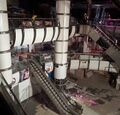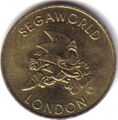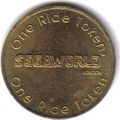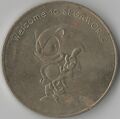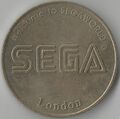SegaWorld London
From Sega Retro
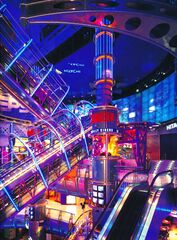
|
| SegaWorld London |
|---|
| Location: The Trocadero, London, United Kingdom |
| Google maps: 51.510490,-0.133022 |
| Opened: 1996-09-07[1] |
| Closed: 1999 |
This teeny-tiny article needs some work. You can help us by expanding it.
SegaWorld London was a Sega World indoor theme park which opened on September 7, 1996. It was housed within the London Trocadero complex within the city of London, UK. Upon launch, the Trocadero site became the flagship Sega World site in Europe, building on earlier success seen at Sega World Bournemouth. It was also the largest indoor arcade on the continent, but has since closed its doors permanently.
Contents
Layout
SegaWorld London was a six-floor indoor arcade with seven medium-scale rides. While often billed as an indoor theme part, much of SegaWorld's attraction was its numerous arcade machines, including full-size 8-player iterations of games such as Daytona USA, and import titles rarely seen in the UK. It was also used, similar to Sega World Bournemouth, for location testing Sega arcade machines.
SegaWorld London originally charged a flat rate at the entrance, which would cover all the rides. This was replaced with a free entry system, where visitors would have to pay for each individual ride. At no point where the arcade machines themselves free play - most operated on a token system.
From the entrance, SegaWorld London would lead visitors up the "rocket escalator" (16.43m in length (with 80m of handrail), 31.5 tons in weight and 193 steps[2] (although it was technically two esclators, not one)) to the sixth "level" (floor), before leading down each level to the exit.
Level 6: Reception
Starting at the top, visitors could pay for ride tickets on this level and try a selection of free Sega Saturn consoles. Also housed on this level is the first ride, the Beast In Darkness motion simulator.
Level 5 : Combat Zone
This floor had no rides, but over 50 fighting games.
Level 4: The Race Track
This floor had over 70 racing games, and also included one of Damon Hill's FW15C racing cars from teh 1993 Formula One season. During that season, Damon Hill drove with Alain Prost for Williams, who were sponsored by Sega at the time (incidentally Prost was used to advertise the Sega arcade at La Tête Dans Les Nuages in France around this period).
The ride on this floor, Aqua Planet was another motion simulator where you wear 3D glasses, and go in an underwater adventure.
Level 3: Flight Deck
This floor contained 20 "flying" games, a McDonalds restaurant and play area, and the rides Space Mission (VR-1) and Mad Bazooka.
The Flight Deck floor housed the first commercially available ex-RAF Harrier Jump Jet, having been towed through London on a boat in the months prior to opening[3].
Level 2: The Carnival
This floor was very large, containing numerous UFO catchers, over 80 video games and 3 rides; Power Sled, House of Grandish and Ghost Hunt.
Level 1: Sports Arena
The final floor, Sports Arena contained 90 sports games, the AS-1 Motion Simulator, and the Sega Store.
History
Development
The Piccadilly Trocadero was originally built in 1896 as a restaurant, before closing in 1965. It re-opened as an entertainment and shopping complex in 1984, but by the early 1990s was struggling to find tenants. In 1994 it was purchased by Burford Group plc, led by Nick Leslau and Nigel Wray, who endeavoured to revamp the site for modern consumers.
At the same time, Sega, fresh from arcade and console video game successes, were making moves in opening Sega-branded arcade centres across Europe. In the case of the United Kingdom, this began with Metropolis in late 1992 and continued with the likes of Sega World Bournemouth and a handful of smaller venues using the "Sega World" name. Sega was itself one of the biggest brands in the UK at the time, riding on the successes of the Sega Master System and Sega Mega Drive (and particularly Sonic the Hedgehog), and was attempting to open a new arcade centre in the region every couple of months.
Sega had already had enormous success in Japan following a similar concept. In particular, the 1994 launch of Joypolis Tokyo has proving to be very lucrative - effectively an indoor theme park, Joypolis took things one step further by housing indoor rides and large scale attractions, and still remains active to this day. The plan was to emulate this idea in other parts of the world, so Sega Europe arranged with Burford Group to build SegaWorld London - a UK version of Joypolis.
Construction began in early 1996 on a planned £45 million project encompassing 100,000 square feet of the Trocadero site (covering seven floors), aiming to be the largest indoor theme park in the world. As well as housing seven dedicated indoor rides, many of its floors would be devoted to arcade machines, and would become a new testing site for Sega's own arcade releases in the years which followed.
Opening
SegaWorld London opened in September 1996, at the height of Sonic the Hedgehog's popularity. From 1997, Pepsi sponsored the Pepsi Max Drop Ride and the Pepsi IMAX cinema, being the first 3D IMAX cinema to appear within the UK. The venue was heavily promoted by mid-90s editions of Sonic the Comic.
However, unlike Joypolis, visitor numbers were not large enough to keep the attraction open in its entirity, and with other financial issues at Sega hovering overhead, the company were forced to sell its stake to new owners in 1999, becoming known as "FunLand".
Demise
In the years that followed the site was considerably stripped down considerably - Pepsi's endorsed features, the Pepsi Max Drop and IMAX Cinema, were turned offline in March 2000 after the opening of the bigger London IMAX elsewhere in the city. The physical Pepsi Max Drop ride was then sold and moved to Funland Hayling Island, an unrelated amusement park based on Hayling Island near Portsmouth.
To minimise costs, FunLand began closing floors, starting with the lower levels, and in 2002 the top two levels were closed, taking the famous rocket escalator with it (although it took until May 2011 for it to be physically removed). FunLand opened a new entrance to accommodate for the change, but at no point was the complex significantly revamped, meaning traces of the SegaWorld layout and closed rides still existed for much of the decade.
FunLand ceased trading in July 2011, leaving only a few arcade machines in front of a locked door where the FunLand entrance once lived. Some machines were moved to nearby arcades; Las Vagas Arcade Soho and The Heart of Gaming, while others moved to the basement of the Trocadero.
With Sega out of the picture, the Trocadero began to decay once again, however Criterion Capital bought the site in 2005 with the view of opening a hotel, the rumoured plan being to completely close the complex in early 2014 to allow construction to begin. In reality only part of the area was closed (such as the Cineworld cinema) - the rest has effectively reverted to its pre-1996 shopping area state. That being said, the basement arcade was closed as well, removing the final traces of SegaWorld in the process.
Gallery
Magazine articles
- Main article: SegaWorld London/Magazine articles.
Promotional material



